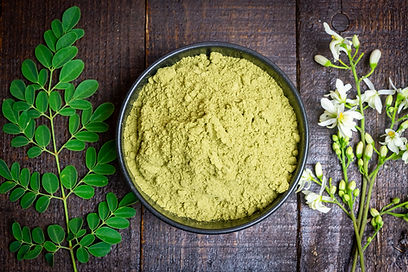
Moringa
Moringa is a multipurpose tree that can fight malnutrition and grows in the most unfavourable areas where most of the other crops can't survive. It is special because it contains high concentration of many nutrients, especially proteins, potassium, calcium, iron, vitamins A and C, vitamins B. All parts of the plant are edible and have multiple uses, from food to wastewater treatment.
Nutrition and bioactive compounds
Moringa is nutritious because raw leaves contain up to 17% proteins (27% in leaf powder, 40% in dry leaves), 13% of carbohydrates (around 40% in leaf powder and dry leaves). Seeds are rich in lipids (app. 40%). Moringa is a source of 18 out of 21 amino acids, among them all essential ones. A portion of 100 g raw leaves suffices for 47% provitamin A, 55% riboflavin (B2), 92% vitamin B6, 62% vitamin C, 31% iron, 41% magnesium, 19% calcium daily needs. Moringa species are known for their antioxidant, anti-inflammatory, anticancer, and antihyperglycemic activities, mostly due to their high content of flavonoids, glucosides, and glucosinolates.


Cultivation
Moringa genus has 13 species, growing mainly in semiarid, tropical, and subtropical areas in southwest Asia, southwest Africa, northeast Africa, and Madagascar. M. oleifera, currently the most researched moringa species, grows best in the temperature range of 25–35°C, under direct sunlight, at the altitude around 500 m, and in slightly acidic to alkaline soil (pH 5.0–9.0). Nevertheless, it can tolerate temperatures up to 48°C, only 250 mm of rain, frost in winter, and a wide variety of soil conditions. In East Africa, it grows at altitudes up to 1350 m, but can be found even higher.
Moringa can be propagated from seeds and cuttings. The pods are generally harvested in the summer, but in some areas even twice a year. Moringa can be cultivated inexpensively and environmentally friendly and can grow on otherwise non-cultivatable dry and nutrient-deficient land. Once its root system is established, it is quite easy to maintain as it is tolerable to the harsh environmental conditions. Consequently, the need for fertilisation and irrigation is significantly lower compared to many other agricultural crops.
Uses
Leaves, flowers, pods, seeds, roots and even bark can be used for bunch of products: food and food additives, animal feed, cosmetics, pharmacy, biofuels, fertilizers or even for water purification. Currently, leaf powder is the most popular product, having around 30% of the moringa market share.
Market and production
The global Moringa Products' Market was estimated at USD 5,000 Million in 2019 and is expected to reach USD 8,400 Million by 2026, with expected growth at a compound annual growth rate (CAGR) of 8% from 2020 to 2027.
The leading market share is held by the Asia Pacific region with India as the leading exporter. Africa, North America, Europe, Latin America, and Middle East contribute moringa products to the global market as well.
